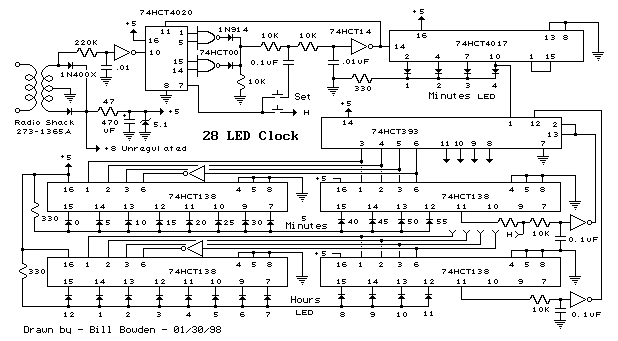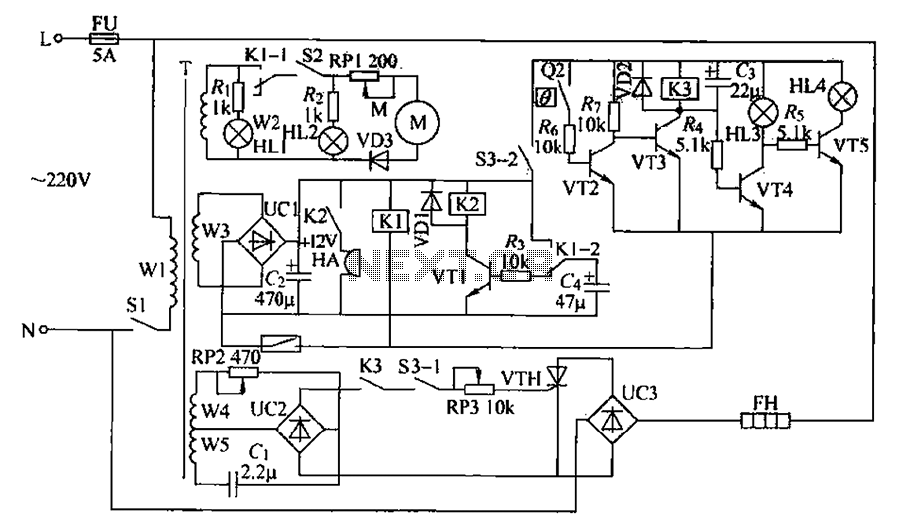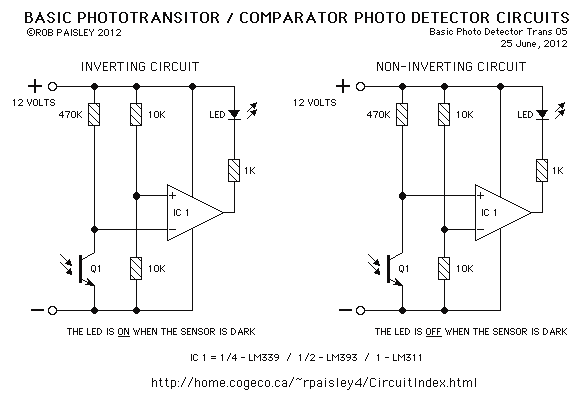
28 LED Clock Timer circuit

This is a programmable clock timer circuit that utilizes individual LEDs to display hours and minutes. Twelve LEDs can be arranged in a circular pattern to represent the 12 hours on a clock face, while an additional 12 LEDs can be positioned in an outer circle to indicate 5-minute intervals within each hour. Furthermore, four additional LEDs are designated to represent 1 to 4 minutes of time within each 5-minute interval.
The programmable clock timer circuit is designed to provide a visual representation of time using light-emitting diodes (LEDs). The inner circle consists of 12 LEDs, each corresponding to an hour from 1 to 12, allowing for easy readability akin to a traditional analog clock. The outer circle complements this by featuring another set of 12 LEDs, each representing 5-minute increments. This arrangement enables users to quickly ascertain the current minute within the hour by observing which of the outer LEDs is illuminated.
To enhance the precision of time indication, four additional LEDs are employed to signify the first four minutes within each 5-minute segment. This allows for a more granular display of time, facilitating detailed tracking of minutes and enhancing the overall functionality of the timer.
The circuit can be controlled by a microcontroller, which can be programmed to handle various timing functions. This includes setting specific times for alarms or reminders. The microcontroller interfaces with the LEDs through a series of output pins, ensuring that the correct LEDs illuminate according to the programmed time settings.
Power management is also an essential consideration in the design of this circuit. A regulated power supply is recommended to maintain consistent brightness across all LEDs and to ensure reliable operation of the microcontroller. Additionally, suitable resistors should be included in the circuit to limit the current flowing through each LED, preventing damage and prolonging their lifespan.
Overall, this programmable clock timer circuit offers a unique and visually engaging method of timekeeping, combining the simplicity of LED indicators with the versatility of programmable electronics.This is a programmable clock timer circuit that uses individual LEDs to indicate hours and minutes. 12 LEDs can be arranged in a circle to represent the 12 hours of a clock face and an additional 12 LEDs can be arranged in an outer circle to indicate 5 minute intervals within the hour. 4 additional LEDs are used to indicate 1 to 4 minutes of time within each 5 minute interval.. 🔗 External reference
The programmable clock timer circuit is designed to provide a visual representation of time using light-emitting diodes (LEDs). The inner circle consists of 12 LEDs, each corresponding to an hour from 1 to 12, allowing for easy readability akin to a traditional analog clock. The outer circle complements this by featuring another set of 12 LEDs, each representing 5-minute increments. This arrangement enables users to quickly ascertain the current minute within the hour by observing which of the outer LEDs is illuminated.
To enhance the precision of time indication, four additional LEDs are employed to signify the first four minutes within each 5-minute segment. This allows for a more granular display of time, facilitating detailed tracking of minutes and enhancing the overall functionality of the timer.
The circuit can be controlled by a microcontroller, which can be programmed to handle various timing functions. This includes setting specific times for alarms or reminders. The microcontroller interfaces with the LEDs through a series of output pins, ensuring that the correct LEDs illuminate according to the programmed time settings.
Power management is also an essential consideration in the design of this circuit. A regulated power supply is recommended to maintain consistent brightness across all LEDs and to ensure reliable operation of the microcontroller. Additionally, suitable resistors should be included in the circuit to limit the current flowing through each LED, preventing damage and prolonging their lifespan.
Overall, this programmable clock timer circuit offers a unique and visually engaging method of timekeeping, combining the simplicity of LED indicators with the versatility of programmable electronics.This is a programmable clock timer circuit that uses individual LEDs to indicate hours and minutes. 12 LEDs can be arranged in a circle to represent the 12 hours of a clock face and an additional 12 LEDs can be arranged in an outer circle to indicate 5 minute intervals within the hour. 4 additional LEDs are used to indicate 1 to 4 minutes of time within each 5 minute interval.. 🔗 External reference





